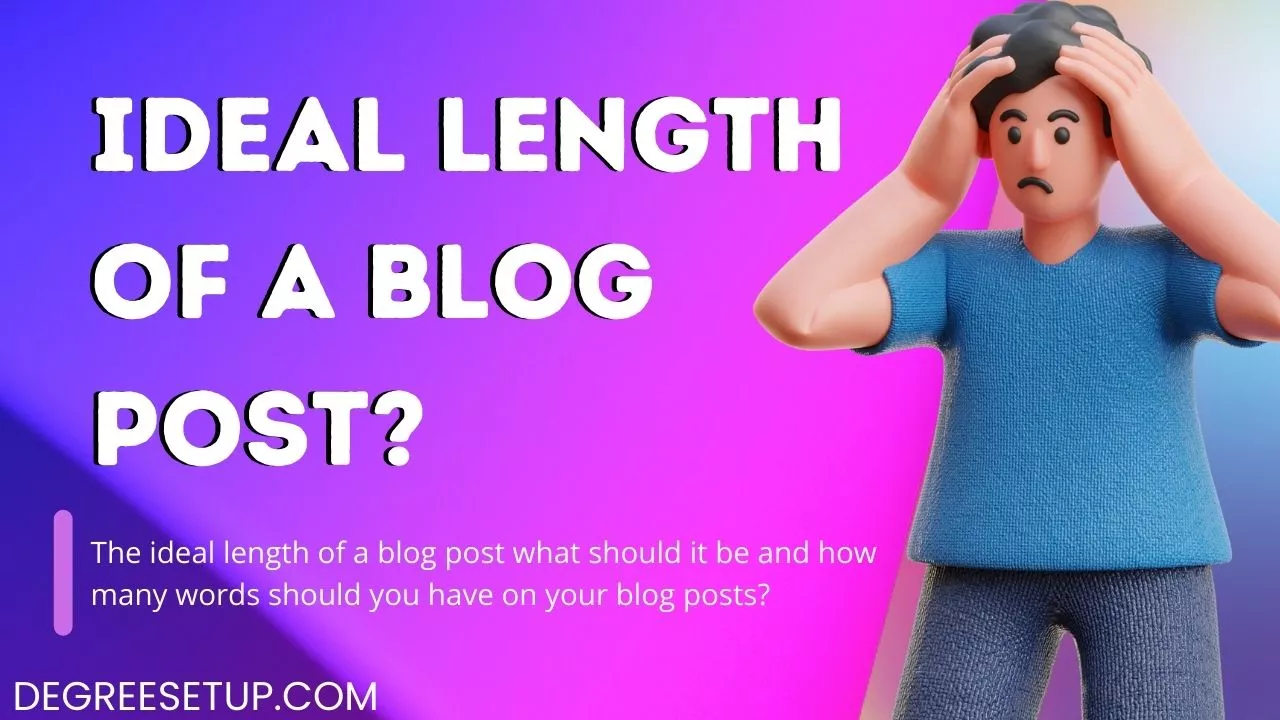
This question also came to mind when I started blogging in 2019. I thought writing only up to a specific word count would help my content rank on search engines.
But as soon as I learned about SEO and how a search engine works, things became much clearer to me about writing a blog post.
While writing any post, you don’t have to worry about anything but giving a detailed answer to your readers.
If you ask me today about what should be the ideal length of a blog post. Here’s what my answer would be.
Wordcount count does not matter while writing a blog post from an SEO point of view. You have to convey your thoughts or share information thru your post in the best way possible. If you can do it in 1000 words, that’s good, but if you have written the same information in a 600-word blog post, that will also rank.
Here’s what google says about word count.
Are you writing to a particular word count because you’ve heard or read that Google has a preferred word count? (No, we don’t).
Google developers.
What do SEO experts say about the word count?
I have read articles similar to this topic, most of which referred to Hubspot.
In that article, it is written that the average word count of their blog article was about 2,574, and now we are in 2022, so the trend has changed.
There are over five to six articles that I have seen linked to the same article as a reference. If you google right now, you may find the top results may be linking to the HubSpot blog post.
There is no denying that lengthy blog posts are suitable for search engines, but if you write short ones, you will also not face any loss. As today people want information fast without any hassle.
Why do most bloggers write longer blog posts?
Writing a longer post gives you many advantages as a blogger.
There are many benefits that you can get from rankings to monetizing perspective.
On the other hand, most users don’t want to read lengthy content and want a quick answer to their search query unless they are looking for a product or fixing a problem.
Here are some advantages of writing a longer blog post.
- Deeply covers a topic – Writing a longer post deeply covers a topic as all the questions about a single topic are answered in that particular post. Readers may find it interesting to read more about a topic they are looking for.
- Increases engagement – In longer posts, people tend to stay more as they read more about the topic on the website. This increases the overall engagement time of the website and helps in rankings as search engines find your site helpful.
- Good for monetization – In a lengthy blog post, readers can see more ads than short ones. For example, if readers see 4 ads on an 800 words blog post, they will see at least 8-10 ads on a 2000 words post. The more ads they will see, the higher your earnings will be.
- Get you backlinks – Backlinks are a significant part of the ranking factor. Getting backlinks is one of the best parts of having a longer blog post. This happens because longer blog posts contain well-researched content, and people find more likely to link them.
- Takes time to outrank – Longer posts rank better because of the quality of information. Writing longer posts takes time, but it becomes competitive to outrank it once ranked on the first page of SERP.
- Contains multiple keywords – Long blog posts consist of multiple sub-headings and topics that generate several keywords. So chances of visitors to your site increase.
How to write a longer blog post?
What are long blog posts?
A blog post or article contains more than 2000+ words. It is considered a long blog post. It should have multiple file formats such as images, text, and videos to look well structured. It takes 15 – 20 minutes to read the content as it is valuable and deeply researched.
You can add five things to make your blog posts longer. These five things consist of text, tables, images, animations, and videos.
Long blog posts are the outcome of a well-researched and informational topic. It takes time to create them, and using the below elements can help create them.
Longer blog posts must include these five things.
- Text – Text is the primary content of your blog post structure. It alone can be used as a form of content and covers about 70% – 90%.
- Tables and data – It is vital if you are giving any information, such as categories, price lists, and names, that must be included using a table. It will make your content look better and longer. You can also use charts to show the data.
- Images – Image provides a visual treat to readers. Using the right images on blog posts helps content rank on search engines. Using 3-5 images in a post can make it longer. Also, if you use infographics, you can attract more visitors.
- Animations – Mostly, I am not in favor of using animation in articles and blog posts. But animations are a must-use if your blogs focus more on designs and products. Using them to blog posts, your content becomes helpful and looks attractive, and the CTC increases.
- Videos – Videos can be helpful content as not many people use them in their blog posts. If you have taken any information from a video, you must include them in your post. Just paste the HTML code using the share option using youtube.
Best ways to format long blog posts.
Use these tips in your blog posts to make them longer and better.
1. Catchy Headlines
Write headlines that can attract the people looking for a specific search query. There are thousands of articles on search engines, but people tend to click on those with appealing headlines.
To write better headlines, you can include powerful words that trigger an emotional response. You can out the list of power words from here.
Using powerful words and writing catchy headlines can increase your CTC, which helps you to gain traffic.
2. Write a solid introduction.
When you write a longer blog post, the intro should engage the readers, and they can read the complete information in the easiest way possible.
To improve your introduction, you can start your content by asking a simple question to the readers.
Then directly answer in a few lines so readers can gain basic knowledge about the topic.
After that, list the sources from which you have taken the information. It can be anything, such as a book, website, research paper, or blog.
Make sure to add some extra lines that can make your readers keep reading the content further.
3. Divide the topic into multiple subheadings.
You can quickly write longer posts when you divide them into parts. Let’s understand this point with an example.
Suppose you want to write an article on ” How to make money online?”.
To divide it, you can simply write subheadings such as:-
- How to make money online? (This is the main title and heading – 300 words).
- Best ways to make money online(1st Subheading – 800 words).
- What are the best platforms to make money online? (2nd Subheading – 300 words).
- What resources do you need to have? (3rd subheading – 300 words).
- Skills you need to learn(4th subheading – 300 words).
- How much money can you earn online? (5th subheading – 200 words).
- Conclusion and FAQs (200 Words)
The total number of words would be about 2500 -3000 words. The world can also depend on writers and how deeply they want to explain the topic.
4. Gather data and stats.
Google loves data, and if you include them in your content, it will likely rank on top. Also, using them in your article will increase your website’s authority.
Readers also like to read stats and numbers as this help those who are reading this if they are finding information for research or to get general knowledge.
There are websites like statista.com that provide stats about various fields.
5. Use relevant images.
Using images on articles make your content structure better. It increases user engagement time.
To make super helpful images, you can create infographics for your articles as most of the info graphs sizes are verticle, making your content look long.
If you use 3-4 images, that would be enough for blog posts that have 2000 words. And avoid using stock images as they are not helpful and have almost no use.
6. Write short paragraphs.
You need to write short paragraphs to make it easy for your readers to go through the content.
Short paragraphs improve the UX experience, and people can read the content without getting bored. It also benefits your site from a monetization point of view.
Read here more about writing paragraphs on your blog post.
7. Give examples
When writing subheadings giving examples would benefit your content and site a lot. For giving examples, you can include screenshots, your images, and research.
Adding examples will increase the content length, make your content more effective to read, and help the users look for detailed information.
8. Include videos
Videos are gaining popularity people tend to shift towards watching video content compared to reading text on the internet. However, there are millions of people who also read blogs.
If you start including videos on your blog posts, it will make the structure long and increase your video view if you own a youtube channel.
If you don’t create videos on your own, it would be okay to use others’ videos by embedding them using HTML codes.
9. Conclude and Include FAQs
Conclusions are essential as they help you write perfect call-to-action singles. Also, including FAQs increases the chance of CTC from search engines. Both are equally important, and you should practice including them in every blog post, whether short or long.
How much time does it take to write a blog post?
If you have read my previous blog post about response posts, I have mentioned that it takes about two hours to write a response post of 1200 words.
Below I have made a table where I have mentioned the average time of writing a blog post with a particular word limit.
| Average Words Per blog post | Beginner (0-6 months) | Experienced (1-2 years) | Professional (3+ years) |
|---|---|---|---|
| 600 words | 60 minutes | 45 minutes | 30 minutes |
| 1000 words | 120 minutes | 90 minutes | 70 minutes |
| 2000 words | 200 minutes | 180 minutes | 120 minutes |
| 3000 words | 300 minutes | 240 minutes | 180 minutes |
| 5000 words | 1 day | 10 hours | 6 hours |
Writing longer blog posts would take an experienced writer about four hours. If you break down this here, the actual time it would take you to write.
- Keyword research and search analysis – 20 minutes.
- Writing SEO title and subheadings – 10 minutes.
- Writing the main content – 1.5 hours.
- Adding images by graphic design and table – 1 hour.
- Editing and proofreading – 30 minutes.
FAQ
How much does a long post cost?
With the price of $0.05, a 2000-word blog post costs about $ 100.
How much does a long blog post take to rank on SERP pages?
If competition is low, it will take about 2-3 months, and if competition is high, 8-9 months.
How many words does a short blog post contain?
A short blog post contains between 500-700 words and is written to answer a small or specific question.


